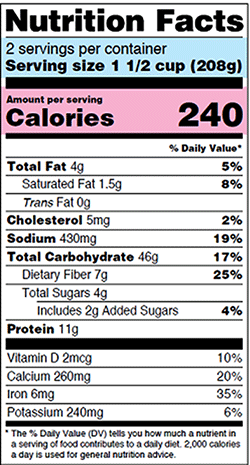Carbohydrate Counting
Carbohydrates are in certain foods such as bread, cereal, rice, potatoes, fruit, milk and sweet desserts. The carbohydrate foods you eat are broken down into glucose and go directly into your blood. The best way to control your blood glucose is to eat the same amount of carbohydrates at each of your meals. Too many carbohydrates and your blood sugar will be too high, and not enough carbohydrates can lead to low blood sugar. In general your carbohydrate intake should be low but some carbohydrates are important to good health.
| Gender | For Weight Loss | For Weight Maintenance | Snacks |
|---|---|---|---|
| Women | 30-45 grams (g) per meal | 45-60 grams (g) per meal | 15 grams (g) per snack |
| Men | 45-60 grams (g) per meal | 60-75 grams (g) per meal | 15 grams (g) per snack |

Example: Look at the meal on the right.
This meal has a combination of foods, some of which have carbohydrates, or, carbs for short. This information can be found on the nutrition label.
The total carbohydrates in this meal is 46 grams.
These foods are low in carbohydrates and do not raise blood sugar. They may be eaten in moderation with meals or as snacks:
- Protein foods: beef, pork, chicken, turkey, fish, eggs, cheese, peanut butter, tofu
- Fats: butter, margarine, oil, salad dressing, mayonnaise, avocado, nuts, sour cream, cream cheese
Checking Labels for Carbohydrate

Look at Serving Size first. The information that follows is based on eating this portion of food.
The portion for this food is 1½ cups.
There are 2 portions in the whole container.
Look at Total Carbohydrate next. This is how many grams (g) that you get when you eat the portion listed above.
This food contains 46 grams of carbohydrates in 1 portion.
If you eat the whole container you will consume 92 grams of carbohydrates.
The “total carbohydrate” number listed on the label includes all types of carbs – sugar, starch and fiber.
- Choose foods with less than 10% Daily Value for saturated fat and sodium.
- Choose foods with less than 6% Daily Value for Added Sugars
- Try to choose foods with more dietary fiber, which is listed on the label under total carbohydrates.
| Food | Carbs in grams |
|---|---|
| Breads | |
| Bread, 1 slice | 15 |
| English muffin | 30 |
| Bagel, large | 45 |
| Pancakes, 2 small | 30 |
| Cornbread, muffin, small | 30 |
| Tortilla, 6 inch | 15 |
| Waffle, 4 inch | 15 |
| Cereal | |
| Cheerios, 1 cup | 20 |
| Frosted flakes, 1 cup | 30 |
| Oatmeal, 1 cup | 30 |
| Raisin bran, 1 cup | 45 |
| Grits, 1 cup | 30 |
| Grains/Starchy vegetables | |
| Rice, 1 cup | 45 |
| Noodles or pasta, 1 cup | 45 |
| Corn, 1 large ear | 30 |
| Corn, peas, ½ cup | 15 |
| Potato, medium, 1 cup | 30 |
| Cooked dry beans, 1 cup | 30 |
| Crackers and Snacks | |
| Ritz or saltine, 5 crackers | 10 |
| Potato chips, small snack bag | 15 |
| Popcorn, 3 cups | 20 |
| Graham, 2 squares | 10 |
| Granola bar, small | 20 |
| Fruits | |
| Apple, orange – small | 20 |
| Banana – 7 inch medium | 30 |
| Grapes – 22 | 20 |
| Juice, 8 oz | 30 |
| Berries – 1 cup | 15 |
| Raisins – ½ cup | 30 |
| Dairy | |
| Milk, plain – 1 cup | 15 |
| Yogurt, plain – 5 oz cup | 10 |
| Yogurt, light, fruit – 5 oz cup | 15 |
| Sweets | |
| Sugar or syrup – 1 tablespoon | 15 |
| Cookies, 2 small | 15 |
| Ice cream – ½ cup | 15 |
| Combination Foods | |
| Soup or stew – 1 cup | 15 |
| Casserole – 1 cup | 30 |
| Potato salad – ½ cup | 15 |
| Fast Foods | |
| Chicken nuggets – 6 pc | 15 |
| Hamburger | 30 |
| French fry – small | 30 |
| Sub sandwich – 6 inch | 45 |
| Pizza, ½ of a med, thin crust | 30 |
Sample menu plans for adults
These meal ideas are about 60 grams of carbohydrates per meal and 15-20 grams per snack.
Make An Appointment
Your health is important. Get expert care.
Offering in-person and virtual visits.
Make an Appointment

